Most of the plants release many substances from their cell cytoplasm to the exterior and they are called as Plant-secretions. Among these secretions, some are beneficial to the plant and some are not. The beneficial substances secreted from the plant parts are called as secretions. The chemical composition of plant secretions highly varies. The secretions may be water, nectar, salt, tannins, resins, latex, gums, digestive enzymes, hormones etc. The present article discusses about the Secretory Tissue in Plants
Secretory Tissue in Plants
Cells or tissue associated with or facilitate the secretion is termed as the secretory cell or secretory tissue. The structure, arrangement and the origin of secretory cells/tissues highly varies.
Classification of Secretory Tissues
Ø The secretory tissue is broadly classified into two categories based on their position in the plant body. They are
(I). External secretory tissue
(II). Internal secretory tissue
(I). External Secretory Tissues
Ø External secretory tissues occur in the external surface of the plants.
Ø They may be unicellular or multicellular and with our without the vascular elements.
Ø They usually develop from the epidermis or sub-epidermal layers of the plant organs.
Ø Three main types of External Secretory Tissues.
(1). Glandular trichomes
(2). Nectaries
(3). Hydathodes
(1). Glandular Trichomes
Ø Glandular trichomes are unicellular or multicellular epidermal hairs with secretory function.
Ø Usually they have a stack and a head.
Ø The head portion will be secretory in nature.
Ø The heads of glandular trichomes are covered with cuticle.
Ø The secretion accumulates in the space between the cell wall and the cuticle.
Ø The cuticle burst to release the secretion.
Ø Glandular Trichomes Examples:
(a). Digestive Glands of Drosera
(b). Salt Glands of Mangroves
(c). Colletors
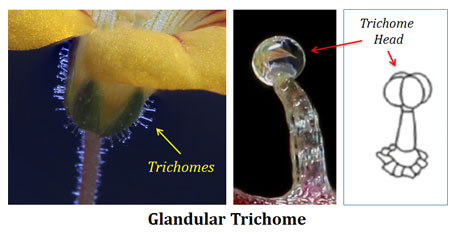
(a). Digestive glands of Drosera
Ø Drosera (sundews) is an insectivorous plant
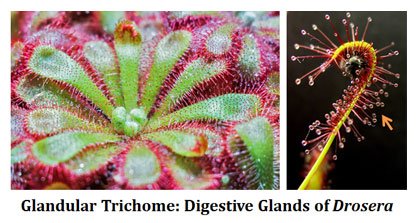 Ø Drosera lure, capture, and digest small insects using stalked mucilaginous glands (tentacles) present on their leaf surfaces.
Ø Drosera lure, capture, and digest small insects using stalked mucilaginous glands (tentacles) present on their leaf surfaces.
Ø Each of these glands are well developed glandular trichomes.
Ø The glandular trichomes of Drosera possess vascular elements.
(b). Salt Glands of Mangrove Plants
Ø Salt glands are external glandular structures present on the epidermis of mangrove plants.
Ø They are abundantly present on the leaves of halophytic plants.
Ø They help to remove excess salts from organs.
(c). Colletors
Ø Colletors are specialized and more complex external secretory structure found in some plants such as Malus, Rosa and Pyrus.
Ø They are found on the young leaf primordia.
Ø Colletors produce a sticky fluid which covers the leaf primordia.
Ø Collectors drop off as the leaf primordia matures.
Ø Thus they provide protection to dormant bud and young leaves.
(2) Nectaries
Ø Nectaries are external secretory structures.
Ø They secrete a sugary fluid called nectar.
Ø The nectar attracts insects and thus helps in pollination.
Ø The nectaries are usually multicellular and can occur in the epidermis, hypodermis or on trichomes.
Ø Nectaries are associated with vascular structures particularly the phloem.
Ø Nectaries have thick cuticle. The nectar accumulates between cuticle and the cell wall.
Ø During the release of nectar, the cuticle ruptures.
Ø The secretion of nectar lasts only for a short time.
Ø Two types of nectaries are present in plants: (a) Floral and (b) Extra-floral.
| You may also like NOTES in... | ||
|---|---|---|
| BOTANY | BIOCHEMISTRY | MOL. BIOLOGY |
| ZOOLOGY | MICROBIOLOGY | BIOSTATISTICS |
| ECOLOGY | IMMUNOLOGY | BIOTECHNOLOGY |
| GENETICS | EMBRYOLOGY | PHYSIOLOGY |
| EVOLUTION | BIOPHYSICS | BIOINFORMATICS |
(a). Floral nectaries
Ø They are the common type of nectaries.
Ø They are associated with flowers.
Ø Usually found on the floral thalamus, base of gynoecium or androecium.
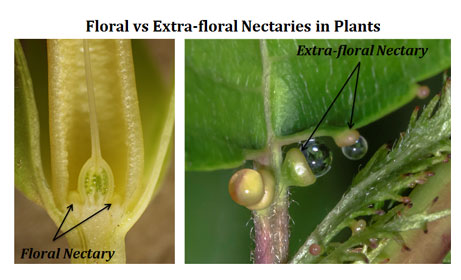
(b). Extra-floral nectaries
Ø Extra-floral nectaries are present on the vegetative parts such as petiole, pedicel or stem.
Ø Extra-floral nectaries are common in families such as Euphorbiaceae, Verbenaceae and Bignoniaceae
(3). Hydathodes
Ø Hydathodes are a type of secretory tissue in leaves.
Ø They are modified pores, especially on a leaf, which exudes water as drops.
Ø The pores of the hydathodes are also called as water stomata.
Ø They facilitate guttation.

Ø Guttation: the secretion of droplets of water from the pores of plants.
Ø Hydathode is made of a group of living cells called epithem with numerous intercellular spaces.
Ø The cells of the epithem lack chloroplasts.
Ø Vascular bundles of leaves end in the epithem.
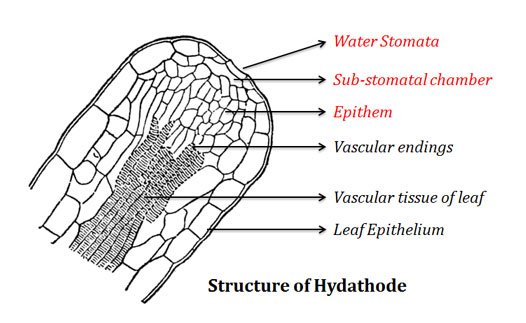
Ø Epithem cells open out into one or more sub-epidermal chambers.
Ø Sub-stomatal chamber communicate with exterior through the pore (water stoma).
Ø Water stomata resemble an ordinary stoma in shape and structure.
Ø However, they are larger than the ordinary stomata.
Ø Hydathodes always stay opened, since they do not have the opening and closing mechanism.
Learn more: Difference between Stomata and Hydathodes
Learn more: Hydathodes: Ultra-structure and Functions
(II). Internal Secretory Tissues
Ø Internal secretary tissue is embedded inside the plants and they cannot be visualized externally.
Ø They store secretory products.
Ø Internal secretory system of plants may be single-celled or multicellular.
Ø In some plants, it is highly specialized and complex.
Ø THREE types of internal secretory systems present in plants:
(1). Internal secretory cells
(2). Secretory cavities and ducts
(3). Laticifers
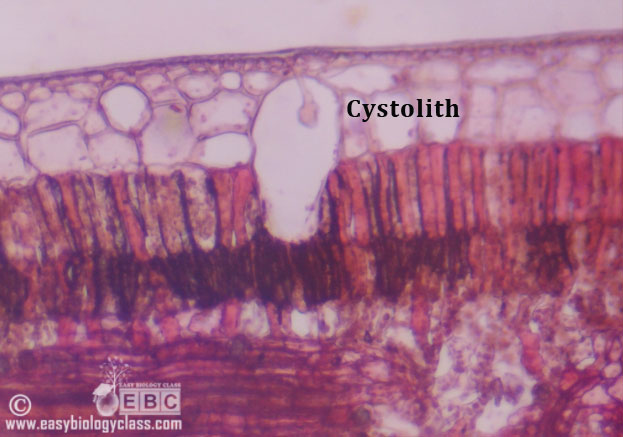
Cystolith of Ficus Leaf
(1). Secretory cells (Idioblasts)
Ø They are specialized secretory cells with secretion. Also called as idioblasts.
Ø Secretory cells are found dispensed in the normal cells.
Ø Idioblasts may be isodiametric or elongated and tube-like.
Ø Most of the idioblasts contain secretory contents.
Ø They can store tannin, mucilage, oils, crystals such as raphides and cystoliths.
(2). Secretory cavities and ducts
Ø These are cavities inside the plant body with secretory contents.
Ø Based on their origin, TWO types of secretory cavities present in plants.
(a). Lysigenous cavity
(b). Schizogenous cavity
(a). Lysigenous cavity
Ø Lysigenous cavity is formed by the lysis of some cells filled with the secretory contents.
Ø They are usually irregularly sized and shaped.
Ø Found in the members of Rutaceae (Citrus, Lemon etc.).
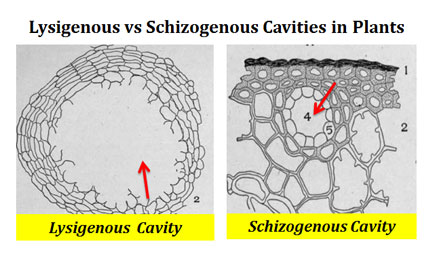
(b). Schizogenous cavity
Ø Schizogenous cavities are formed by the separation of cells by the breakdown of middle lamella (no cell lysis occurs here).
Ø These cavities are more or less isodiametric and circular in cross-section.
Ø Schizogenous cavities are internally lined with interact secretory cells called epithelial cells.
Ø Epithelial cells are surrounded by thick walled casing cells.
Ø The epithelial cells secrete the contents into the cavity.
Ø Example: Secretory cavities found in members of Asteraceae, Coniferales and Apiaceae.
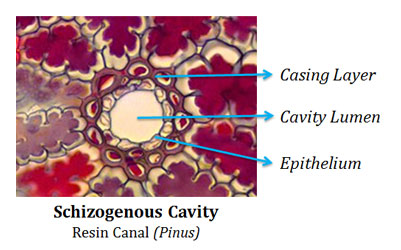
(3). Laticifers (laticifer tissues)
Ø Laticifers are fused tube-like cells filled with a fluid called latex.
Ø Laticifers are usually confined to phloem (bark) however, they can occur in any part of the body.
Ø TWO types of laticifers in plants.
(a). Non-articulate laticifers
(b). Articulate laticifers
(a). Non-articulate laticifers
Ø Non-articulate laticifers are also called as latex cells.
Ø They are originated from a single cell.
Ø They elongate in the plant organ by intrusive growth.
Ø They occupy the intercellular spaces of other cells.
Ø Non-articulate laticifers may be branched or unbranched.
Ø Example:
Ø Un-branched non-articulate laticifers: Euphorbia, Jatropha, Asclepias, Nerium, Ficus
Ø Branched non-articulate laticifers: Ficus
(b). Articulate laticifers
Ø They are also called as compound laticifers.
Ø They originate from a series of cells and these cells are arranged end to end.
Ø The common wall between the cells may be intact or disorganized.
Ø Articulate laticifers resemble the xylem vessels and thus they are called latex vessels.
Ø There are two types of articulate laticifers:
(i). Articulate anastomosing
(ii). Articulate non- anastomosing
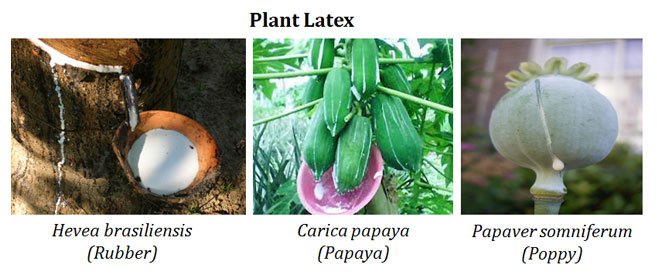
(i). Articulate anastomosing
Ø In articulate anastomosing laticifers, lateral connections are established with similar laticifers to form reticulate (network) structures.
Ø Example: Hevea, Manihot
(ii). Articulated non-anastomosing
Ø In articulate non-anastomosing laticifers, NO lateral connections are established.
Ø Examples: Ipomoea, Musa, Convolvulus
Cell structure of laticifers
Ø Laticifer cells contain living protoplast.
Ø Vacuoles are well developed and it stores the latex.
Ø Cells usually multinucleate (coenocytic).
Ø Latex may be milky white or coloured or colourless.
Ø Milky white latex : Euphorbia, Hevea
Ø Courless latex : Nerium
Ø Orange/ Yellow latex: Papaver
Chemical composition of latex
Ø Plant latex is a mixture of many organic compounds.
Ø They contain carbohydrates, organic acids, alkaloids, terpenes, resins and enzymes.
Ø Latex of Euphorbia mili contains dumbbell shaped starch grains.
Ø Latex of Papaver somniferum contains alkaloids (morphine, codeine).
Ø Latex of Carica papaya contains digestive enzyme papain.
Ø Latex of Achras saporta contains chicles (used for making chewing-gum).
Ø Latex of Hevea contains rubber. The rubber particles are suspended in the latex. When latex is removed from the plants the rubber particles clumps tougher.
| You may also like... | ||
|---|---|---|
| NOTES | QUESTION BANK | COMPETITIVE EXAMS. |
| PPTs | UNIVERSITY EXAMS | DIFFERENCE BETWEEN.. |
| MCQs | PLUS ONE BIOLOGY | NEWS & JOBS |
| MOCK TESTS | PLUS TWO BIOLOGY | PRACTICAL |
You might also like…
@. Tissue Systems: Parenchyma | Collenchyma | Sclerenchyma | Xylem | Phloem |
@. Plant Anatomy Lecture Notes
Download the PPT of Secretory Tissue in Plants
https://www.easybiologyclass.com/secretory-tissue-in-plants-ppt-structure-classification-and-examples/

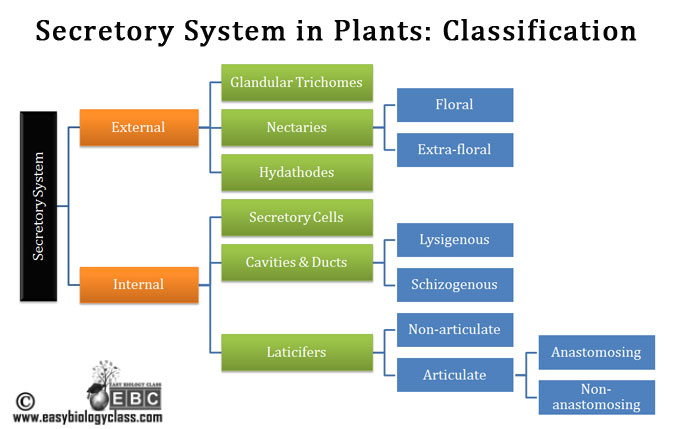
Explained in a very well manner .Helped me a lot thank you so much .
Thank you
Keep visiting easybiologyclass